Tennis players who want to dominate the court need one critical skill above all others: explosive first step quickness.
Incorporating explosive movement training tennis into your practice routine can significantly enhance your on-court performance.
The difference between reaching a difficult shot and watching it sail past you often comes down to those first few milliseconds of movement.
Explosive movement training focuses on developing the power and neuromuscular coordination needed to accelerate instantly in any direction. Incorporating explosive movement training tennis gives you the edge to reach more balls and set up better shots.
By focusing on explosive movement training tennis, you can improve your agility and speed during matches.
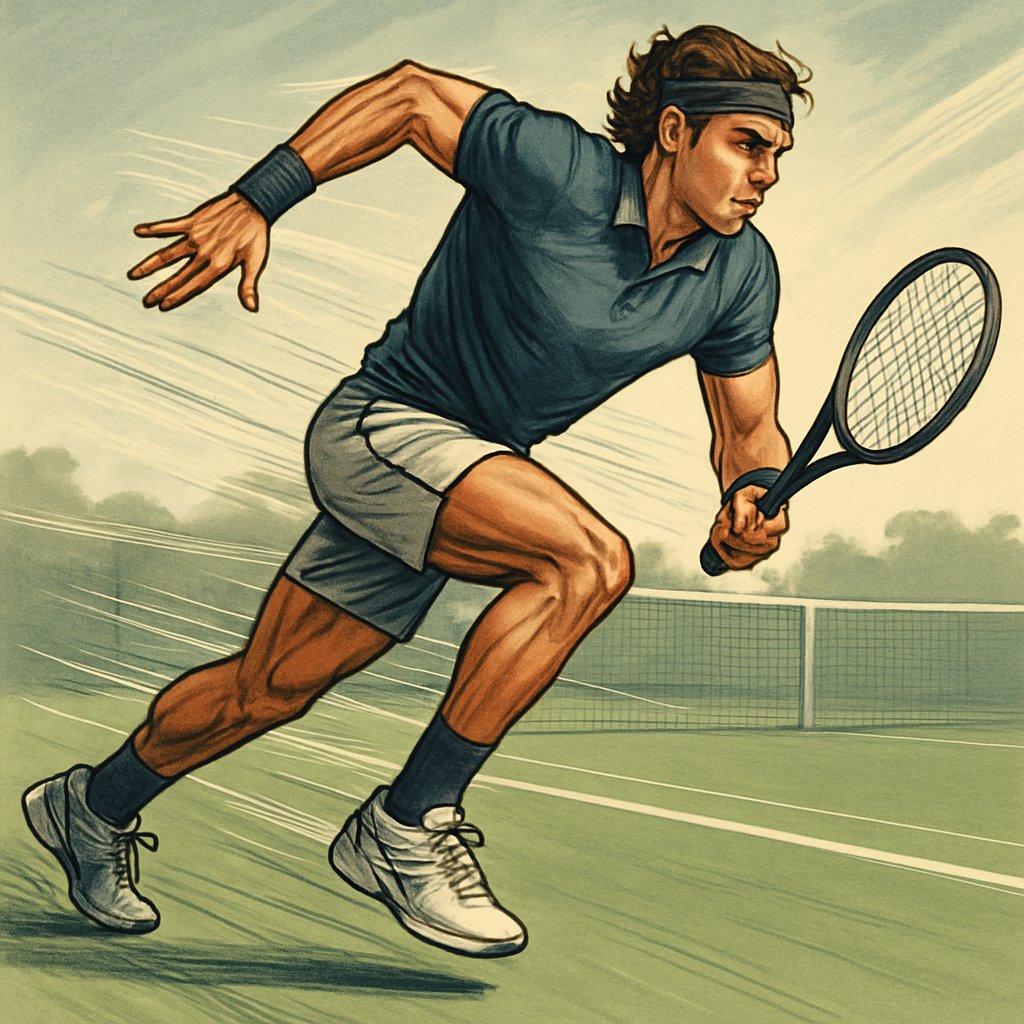
Your ability to explode from a stationary position determines how effectively you can respond to your opponent’s shots.
Whether you’re moving forward to attack a short ball or sliding wide to defend against a sharp angle, that initial burst of speed sets the tone for the entire rally.
The best players in the world have mastered this skill through specific training methods that target the muscles and movement patterns used in tennis.
Modern tennis demands players who can change direction quickly while maintaining balance and control.
Plyometric exercises and tennis-specific drills can transform your court coverage and reaction time.
When you develop explosive first step quickness, you’ll find yourself in better position more often, leading to more aggressive shot selection and fewer defensive scrambles.
Explosive movement training tennis not only enhances speed but also improves overall performance on the court.
Additionally, explosive movement training tennis plays a crucial role in injury prevention.
Key Takeaways
- Explosive first step training improves your ability to reach difficult shots and maintain court position
- Plyometric exercises and tennis-specific movement drills are the most effective methods for developing quickness
- Better acceleration leads to improved shot selection and more offensive opportunities during matches
Understanding First Step Quickness in Tennis
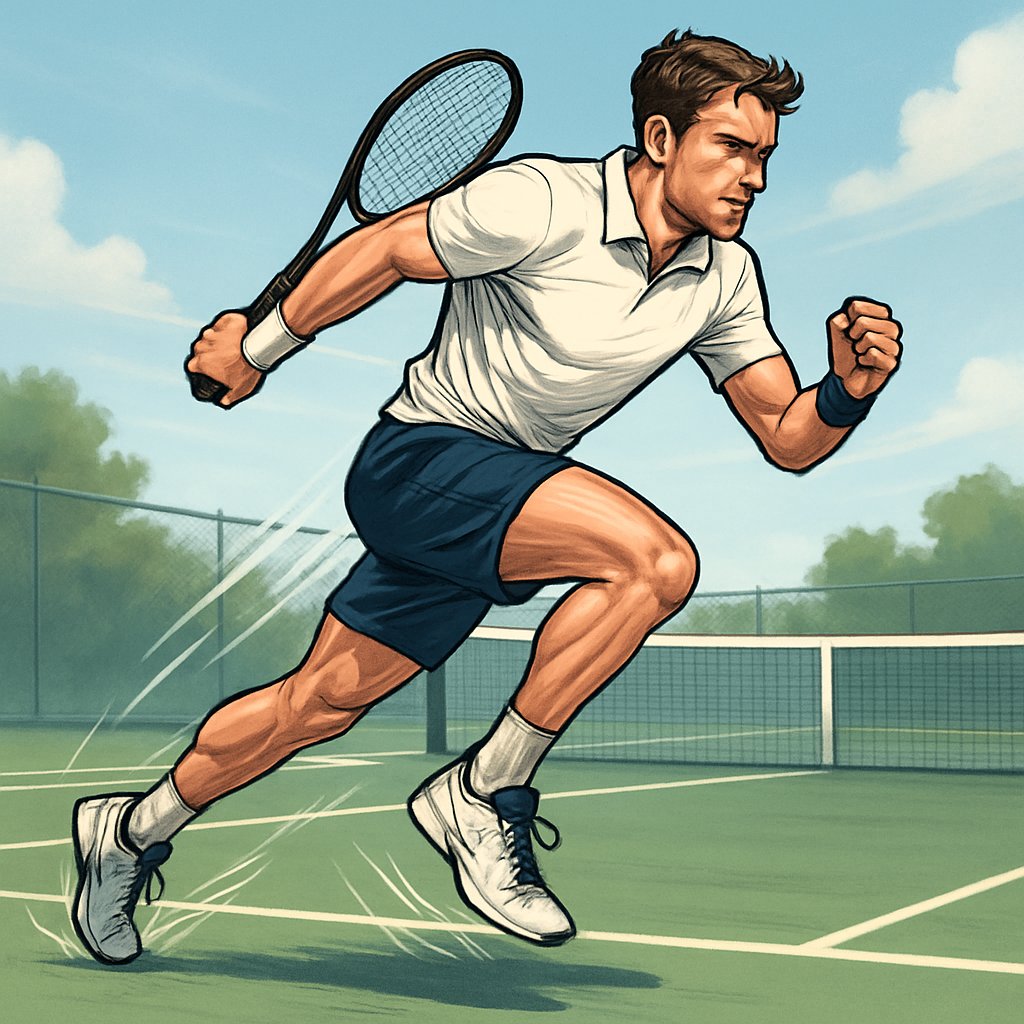
First step quickness forms the foundation of tennis movement. It involves rapid acceleration from a stationary position within the first 2-5 steps.
Adopting explosive movement training tennis can lead to a more dynamic playing style.
The biomechanics require coordinated muscle activation patterns that generate explosive force through proper body positioning and weight transfer.
Defining First-Step Acceleration
First-step acceleration in tennis covers your initial 2-5 steps in any direction from a ready position.
This includes forward sprints to the net, lateral movements along the baseline, and diagonal cuts to corner shots.
Focusing on explosive movement training tennis enhances your overall court coverage ability.
Your acceleration phase differs from top-speed running. During these crucial first steps, you generate maximum force against the ground to overcome inertia.
The goal is reaching your target position quickly, not achieving maximum velocity.
Utilizing explosive movement training tennis allows players to respond more effectively to fast-paced matches.
Key directions for first-step movement:
-
- Linear forward (approaching net)
- Linear backward (retreating from baseline)
- Lateral left and right (baseline coverage)
To maximize benefits, make sure to integrate explosive movement training tennis into your regular workouts.
- Diagonal cuts (reaching wide balls)
Your reaction time plays a major role in first-step effectiveness.
Elite tennis players respond explosively out of the split-step when they receive visual information about ball direction and speed.
Biomechanics of the First Step
Your first step begins with proper body positioning in the ready stance.
Your feet should be shoulder-width apart with weight distributed on the balls of your feet.
Knees stay slightly bent and your center of gravity remains low.
The split-step serves as your launching platform for explosive movement.
You perform a small hop that lands just as your opponent contacts the ball. This timing lets you push off immediately in any direction.
Muscle activation sequence:
- Preparation phase – Core muscles engage to stabilize your torso
- Drive phase – Glutes and quadriceps generate primary force
- Push-off phase – Calves provide final propulsion
Your first step involves a crossover pattern for lateral movement.
You step across your body with the outside foot while pushing off with the inside leg. This technique maximizes your stride length and keeps you balanced.
Role of Explosiveness in Tennis Movement
Explosiveness determines how quickly you can change from static to dynamic movement.
Tennis requires explosive responses under pressure for effective court coverage and stroke preparation.
Your explosive power comes from fast-twitch muscle fibers that contract rapidly.
Incorporating explosive movement training tennis can lead to quicker adjustments during intense rallies.
These fibers generate high force output for short bursts. Training these fibers improves your ability to accelerate quickly from any position.
Benefits of explosive first steps:
- Better court coverage and defensive positioning
- Earlier arrival at ball contact point
- Improved stroke preparation time
- Faster recovery between shots
Players who master explosive movement gain significant advantages in point construction.
You can reach defensive shots and convert them into offensive opportunities through superior positioning.
Your explosiveness also affects your ability to stop and change direction. The same muscle groups that generate initial acceleration help you decelerate and redirect your momentum for the next shot.
Key Components of Explosive Movement
Overall, explosive movement training tennis contributes to a well-rounded athletic performance.

Explosive tennis movement depends on three main areas that work together.
Your balance and coordination create the foundation, while proper footwork gives you the base to move quickly. Fast reaction time lets you respond to your opponent’s shots.
Balance and Coordination for Quickness
Balance forms the base of all explosive tennis movements.
You need to stay centered over your feet to change direction quickly without falling or stumbling.
Core stability helps you maintain balance during rapid movements.
Your core muscles keep your body steady when you push off for a quick first step.
Coordination links your upper and lower body movements together.
When you move to hit a ball, your arms and legs must work as one unit.
Practice these coordination drills:
-
- Single-leg stands for 30 seconds each leg
Incorporating these drills into your routine enhances your execution of explosive movement training tennis.
-
- Balance board exercises while holding a tennis racket
These coordination drills can complement your explosive movement training tennis efforts.
- Cross-pattern movements like opposite arm and leg reaches
Athletes rely on coordination to move efficiently.
Poor coordination wastes energy and slows down your movement.
Your proprioception, or body awareness, improves with practice. This helps you know where your body is in space without looking.
Footwork Essentials for Tennis
Proper footwork starts with staying on the balls of your feet. This ready position lets you push off in any direction quickly.
Your foot placement determines how fast you can move. Keep your feet shoulder-width apart for the best balance and power.
Split step timing is crucial for tennis movement.
Effective footwork techniques are essential for succeeding in explosive movement training tennis.
You should land your split step as your opponent hits the ball.
Key footwork elements include:
- Small, quick steps instead of long strides
- Weight forward on the balls of your feet
- Knees slightly bent for better push-off power
- Arms pumping to help with momentum
Footwork efficiency separates good players from great ones.
Clean footwork patterns save time and energy during points.
Your first step should be short and directed toward the ball. Long first steps often lead to poor balance and slower recovery.
Importance of Reaction Time
Reaction time measures how quickly you respond to visual cues.
In tennis, this means seeing the ball leave your opponent’s racket and starting to move.
Visual processing skills can be trained through specific drills.
Your eyes must track the ball and send signals to your brain quickly.
Mental preparation helps improve reaction time.
When you anticipate where shots might go, you can react faster.
Practice these reaction drills:
- Light reaction training with colored signals
- Ball drop exercises to improve hand-eye coordination
- Mirror drills copying a partner’s movements
Athletes can develop quicker reactions through consistent training.
Strength and speed training together foster explosive movement training tennis benefits.
Your nervous system adapts to repeated stimulus over time.
Decision-making speed matters as much as physical reaction time.
Lastly, implementing explosive movement training tennis in your regimen can elevate your overall game strategy.
You must quickly choose which shot to hit and where to move.
Training Techniques to Improve First-Step Acceleration
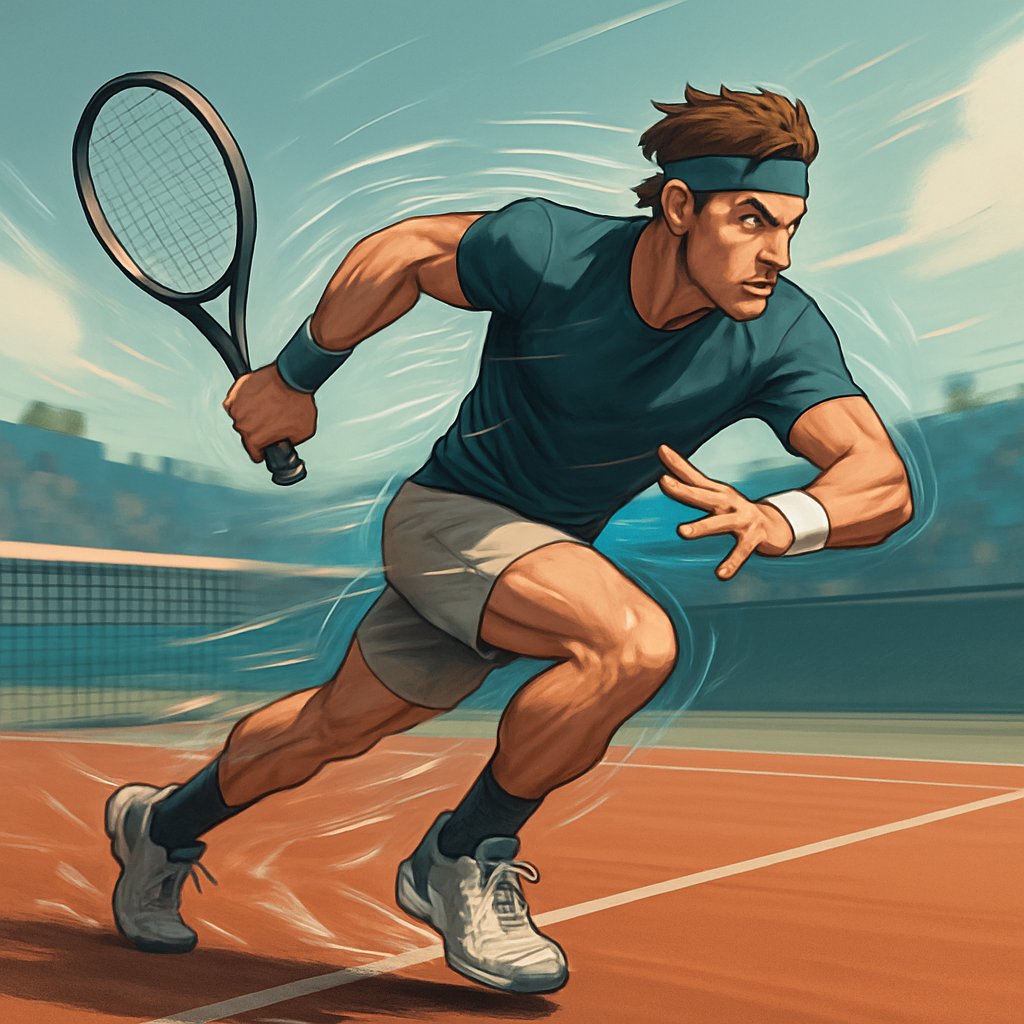
Effective first-step acceleration training combines plyometric exercises, sport-specific drills, and resistance methods to build explosive power.
These techniques target the key muscle groups and movement patterns tennis players need for quick directional changes.
Utilizing Plyometric Exercises
Plyometric exercises are fundamental to improving your explosive movement training tennis capabilities.
Plyometric exercises build the explosive power you need for faster first steps on the tennis court.
These exercises train your muscles to produce maximum force in minimal time.
Jump Squats are one of the most effective plyometric movements for tennis players.
Start in a squat position and explode upward as high as possible. Land softly and immediately drop back into the squat position.
Box jumps develop vertical power that translates to forward acceleration.
Use a box 12-18 inches high and focus on landing softly with bent knees.
Lateral bounds specifically target tennis movement patterns.
Jump sideways from one foot to the other, covering as much distance as possible. This mimics the lateral movements common in tennis.
Single-leg hops build unilateral power and stability.
Hop forward, backward, and sideways on one leg for 10-15 repetitions before switching legs.
Tuck jumps improve your ability to generate force quickly.
Jump up and pull your knees toward your chest, then land softly and immediately repeat.
Jumping drills directly correlate with enhancing your explosive movement training tennis outcomes.
Perform plyometric exercises 2-3 times per week with full recovery between sessions.
Start with 3 sets of 5-8 repetitions for each exercise.
These training techniques are vital for anyone serious about explosive movement training tennis.
Acceleration Drills for Tennis
Tennis-specific acceleration drills train the exact movement patterns you use during matches.
These drills improve your reaction time and first-step quickness in game situations.
A-Skip drills teach proper acceleration mechanics.
Drive your knees high while maintaining a forward lean. Focus on quick ground contact and driving your arms in sync with your legs.
Falling starts develop explosive acceleration from a static position.
Lean forward until you almost fall, then drive hard with your first step to regain balance. This mimics the explosive start needed in tennis.
Wall drives improve your acceleration posture and leg drive.
Face a wall with your hands pressed against it and drive your knees up alternately as fast as possible.
Sprint intervals build acceleration endurance.
Sprint 10-20 yards at maximum effort, walk back, and repeat 8-10 times.
Shadow tennis drills combine acceleration with tennis movements.
Practice explosive starts followed by forehand or backhand swings. This trains acceleration in tennis-specific positions.
Cone drills improve directional changes.
Set up cones in various patterns and practice explosive starts in different directions.
Resistance Band Training Methods
Resistance band training adds load to acceleration movements. This forces your muscles to work harder and build more power.
Resisted sprints use bands around your waist for overload during acceleration. Have a partner hold the band or anchor it to something solid.
Resistance band methods can amplify your explosive movement training tennis effectiveness.
Sprint forward against the resistance for 10-15 yards. You’ll feel the difference right away.
Band-assisted acceleration lets you move faster than usual. Ask a partner to pull you forward with the band so you can train your nervous system at higher speeds.
Lateral resistance walks target the muscles you use for side-to-side tennis moves. Put a band around your ankles and step sideways, keeping tension in the band.
Monster walks with bands work your glutes and hips. Keep the band at your ankles and walk forward with wide steps.
Release runs combine resistance and unassisted acceleration. Start with band resistance for 5-10 steps, then have your partner let go.
When the resistance disappears, you’ll accelerate even faster. It’s a weird feeling, but it works.
This variation can also enhance your explosive movement training tennis routine.
Use light to moderate resistance so you keep good form. Heavy bands mess with your movement and aren’t worth it.
Essential Explosive Drills and Exercises
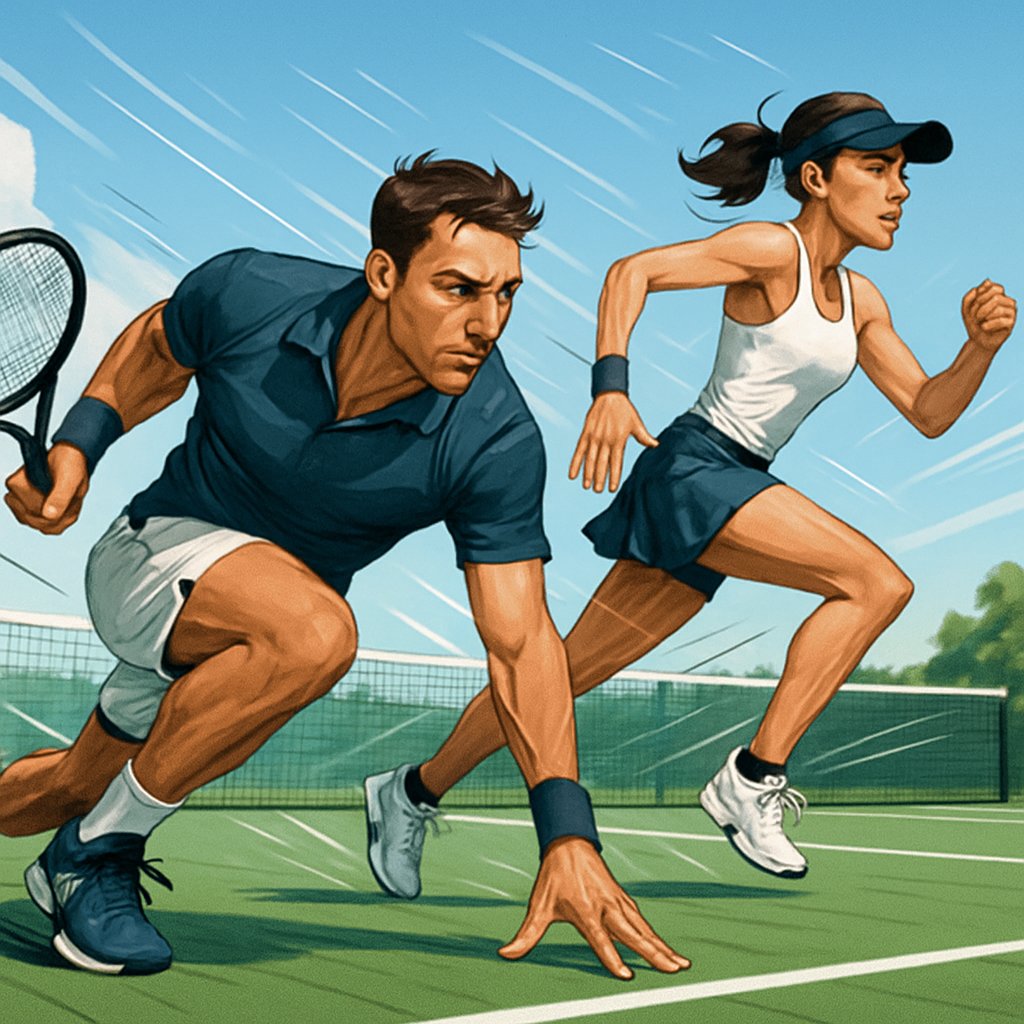
These four drills hit different parts of explosive movement for tennis. Each one builds muscle groups and movement patterns that help you cover the court faster.
Agility Ladder Drills for Speed
Agility ladder drills boost foot speed and coordination. The ladder makes you take quick, precise steps while staying balanced.
Two-Feet-In-Each-Box is the classic drill. Step both feet into each box, moving forward as fast as you can.
Keep your knees bent and stay on your toes. Simple, but it works.
In-In-Out-Out adds a side-to-side challenge. Step both feet in, then both feet out on alternating sides.
This mimics the lateral movement you need for tennis. It feels awkward at first, but you’ll get it.
Icky Shuffle mixes forward and lateral movement. Step your right foot into the first box, then your left, then your right foot outside the ladder.
Bring your left foot into the next box, then keep the pattern going. It takes a bit of practice to get smooth.
Do these drills 3-4 times a week. Each pattern should last 15-20 seconds, then rest for 30 seconds.
Focus on fast, light steps. Don’t worry about power here.
Start slow until the patterns feel natural. Speed up as you get better.
Weighted Squat Jumps and Power
Weighted squat jumps build explosive power in your legs. Hold a dumbbell or medicine ball at your chest as you jump.
Stand with your feet shoulder-width apart. Lower into a squat until your thighs are parallel to the ground.
Keep your chest up and your core tight. Don’t let your knees cave in.
Jump Phase: Explode up as high as you can. Drive through your heels and fully extend your hips.
Land softly on your toes with bent knees. This saves your joints.
Use about 10-20% of your body weight for resistance. Do 3 sets of 6-8 jumps and rest 2-3 minutes between sets.
Safety Tips:
-
- Always warm up first
Clapping pushups improve your upper body strength, benefiting your explosive movement training tennis.
- Land with soft knees
- Stop if your knees or back hurt
Frog Jumps for Lower Body Strength
Frog jumps build the horizontal power you need for quick direction changes. This hits your glutes, quads, and calves all at once.
Start in a deep squat with your hands touching the floor. Keep your chest up and weight on your heels.
Jump forward as far as you can while staying low. Land back in that same squat position, hands down again.
Progression Options:
-
- Beginner: 3 sets of 5 jumps
- Intermediate: 3 sets of 8 jumps
- Advanced: 3 sets of 12 jumps
Jump training like frog jumps is pivotal for explosive movement training tennis.
Rest 90 seconds between sets. Try to cover 3-4 feet with each jump, focusing on distance not height.
Staying low mimics the ready stance in tennis. This helps you accelerate faster to reach shots.
Keep your core tight the whole time. Stability matters for quick changes on court.
Clapping Pushups for Upper Body Explosiveness
Clapping pushups build upper body explosive power for fast arm moves in serves and groundstrokes. That quick push transfers right into your swing.
Start in a normal pushup position. Lower your chest to about an inch off the ground.
Keep your core tight and your body straight. No sagging hips.
Push up explosively so your hands leave the floor. Clap your hands, then catch yourself as you land.
Incorporating explosive movement training tennis can set you apart in competitive scenarios.
Modification for Beginners: Skip the clap and just push up as fast as you can.
Do 3 sets of 5-8 reps. Rest 2 minutes between sets.
If clapping pushups are too hard, work on regular pushups first. You’ll get there.
The quick arm action fires up your nervous system for rapid muscle activation. That means faster racquet prep and swing speed.
Form Tips:
- Keep your body rigid
- Land soft to protect your wrists
- Stop if your shoulders hurt
Advanced Movement Patterns and Reaction Training
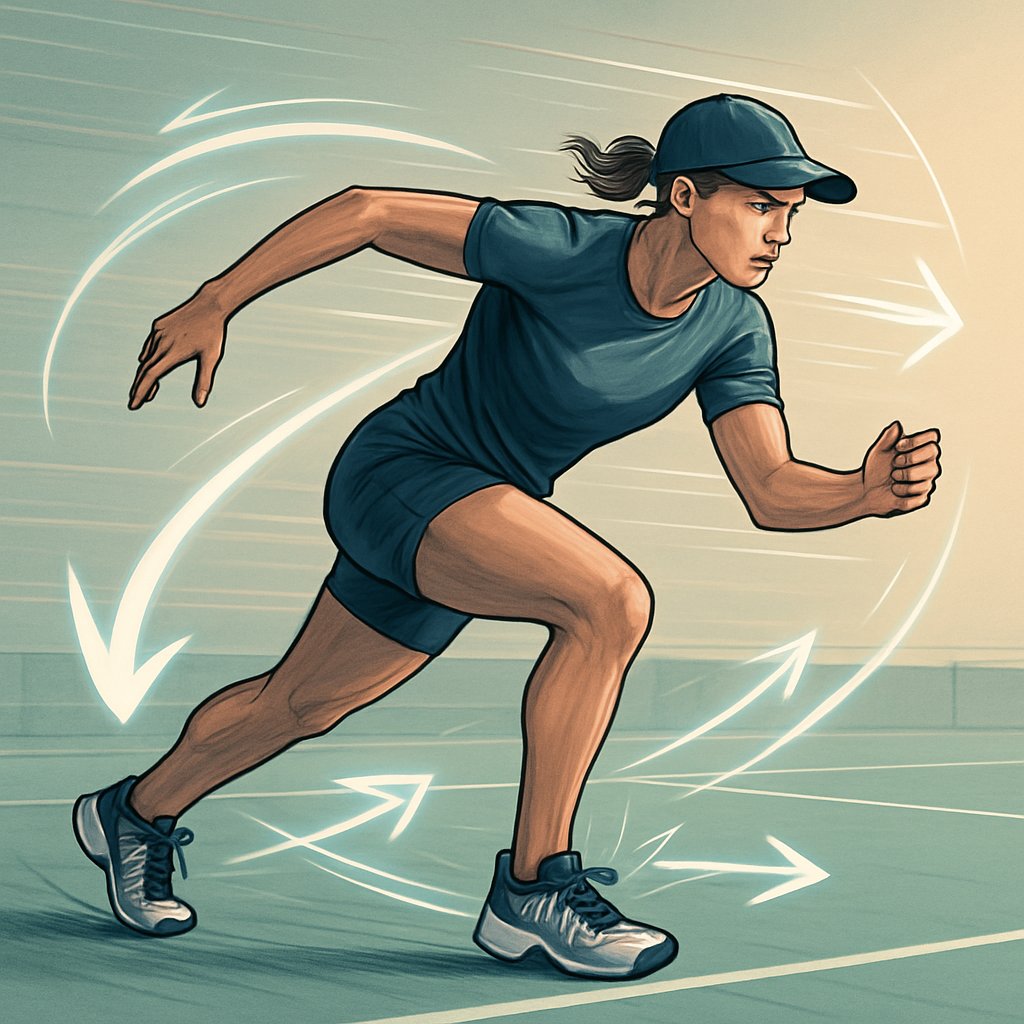
These advanced moves target explosive acceleration with single-leg power and dynamic patterns. Training explosive first-step speed takes focused work on reaction time, muscle activation, and changing direction.
One-Legged Hops and Lateral Quickness
Practicing explosive movement training tennis through varied drills enhances adaptability during matches.
Single-leg drills build the strength you need for tennis. Most actions on court happen on one foot during quick moves.
Forward Single-Leg Hops:
- Stand on your right foot with a slight knee bend
- Hop forward 12-18 inches, landing softly on the same foot
- Try to keep ground contact under 0.2 seconds
- Do 8-10 hops, then switch legs
Lateral Single-Leg Bounds:
- Start on your left foot in an athletic stance
- Bound sideways to your right, landing on your right foot
- Push off right away to return to the start
- Stay low the whole time
Single-leg explosiveness training builds the specific power you need for tennis footwork. Usually your weaker leg limits your court speed, so don’t skip either side.
Jumping Lunges for Dynamic Power
Jumping lunges mix strength, power, and coordination. This move mimics the explosive push-off you need for a fast first step.
Explosive movement training tennis emphasizes the connection between strength and agility.
Basic Jumping Lunge Technique:
- Start in a lunge with your right foot forward
- Lower until your back knee nearly touches the ground
- Jump up explosively, switching legs in mid-air
- Land softly in a lunge with your left foot forward
- Repeat right away
Advanced Variations:
- Add 45-degree direction changes as you jump
- Hold light dumbbells for extra resistance
- Try these on grass or sand for a challenge
Focus on jumping as high as you can while landing clean. The explosive drive matches the muscle firing you need for tennis acceleration.
Staggered Stance and Falling Starts
Falling starts teach acceleration mechanics and boost reaction time. The staggered stance is just like your tennis ready position.
Falling Start Setup:
- Stand with your dominant foot 6 inches behind your other foot
- Lean forward until you have to step or you’ll fall
- Take 3-5 explosive steps forward
- Drive your arms and keep leaning forward
Reaction Integration:
- Have a partner yell “go” at random times
- React to visual cues like a dropped tennis ball
- Try starts in different directions from the same stance
Resistance sprint training and reaction footwork help you move like you do in matches. Your first step speed improves when you train the real positions you’ll use on court.
Deceleration and Change of Direction in Tennis
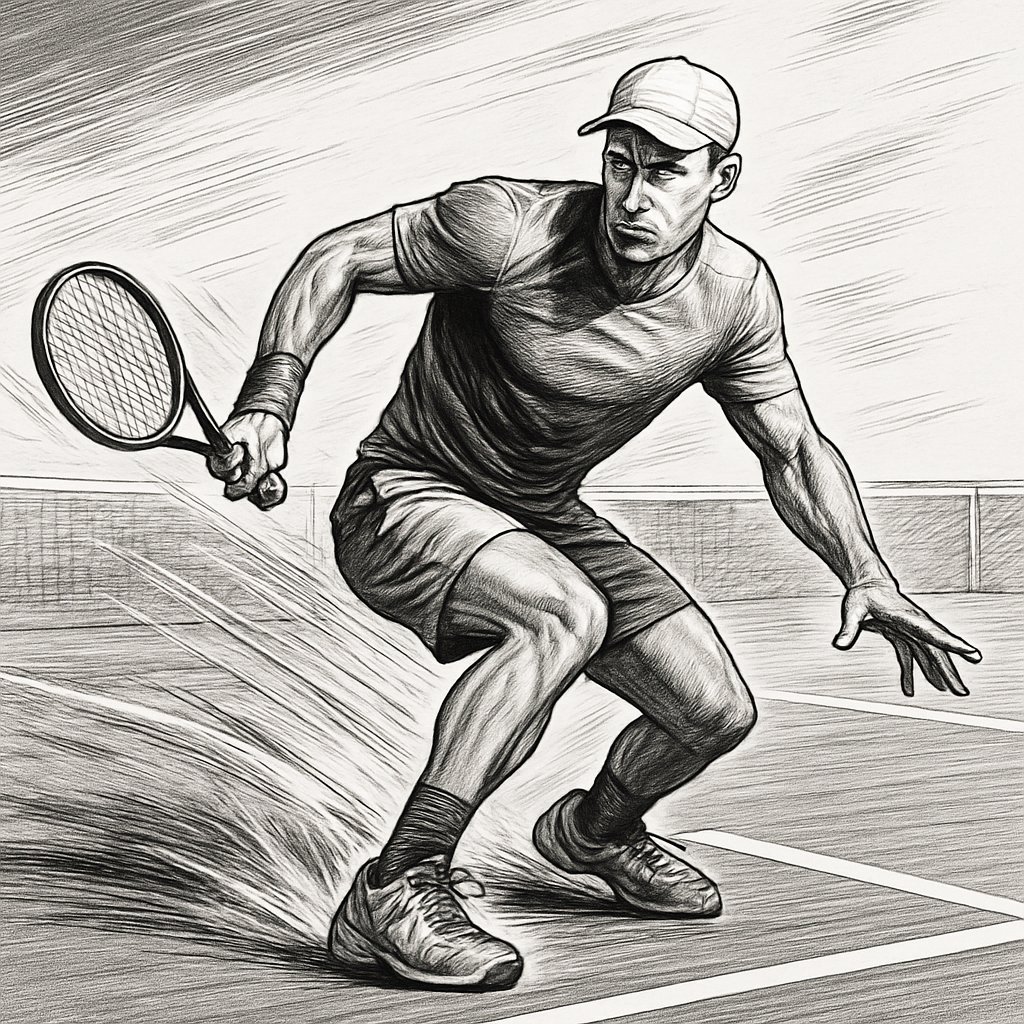
Efficient deceleration is key for quick direction changes during points. Learning good braking skills and doing the right drills makes you cover the court better and helps you avoid injuries.
Learning proper techniques for explosive movement training tennis can minimize injury risk.
Techniques for Controlled Braking
Your ability to slow down fast decides how quickly you can change direction. If you can’t decelerate well, your momentum just works against you.
Proper Body Position:
- Keep your chest up and shoulders back
- Bend at your hips and knees, not your waist
- Land on the balls of your feet, not your heels
Footwork Mechanics:
- Take shorter, quicker steps as you approach the ball
- Plant your outside foot first when you want to change direction
- Push off with your legs, not just your feet
Deceleration training fixes common movement problems that show up in real play. Focus on controlling your speed in those last 2-3 steps before you hit.
Your explosive movement depends on how well you can brake. Without good deceleration, you just waste energy and lose balance on your shots.
Deceleration Drills to Prevent Injury
Sprint and Stop Drill:
- Sprint forward 10 yards at full speed.
- Decelerate over 3-4 steps using good form.
- Hold your final position for 2 seconds.
- Repeat 6-8 times and rest fully each time.
Lateral Brake Drill:
- Start in ready position at center court.
- Shuffle quickly to the sideline.
- Plant your outside foot and stop completely.
- Return to center using crossover steps.
Direction Change Series:
Integrating these methods into explosive movement training tennis leads to impressive results.
- Run forward 5 steps, then brake and backpedal.
- Side shuffle right, brake, then shuffle left.
- Complete 3 rounds with 30 seconds rest in between.
These drills help your muscles handle the forces from stopping fast. Try them 2-3 times a week during your training sessions.
Most tennis points have 3-7 direction changes. Deceleration skills really matter for competitive play.
Integrating Explosive Movement Training Into Tennis Practice
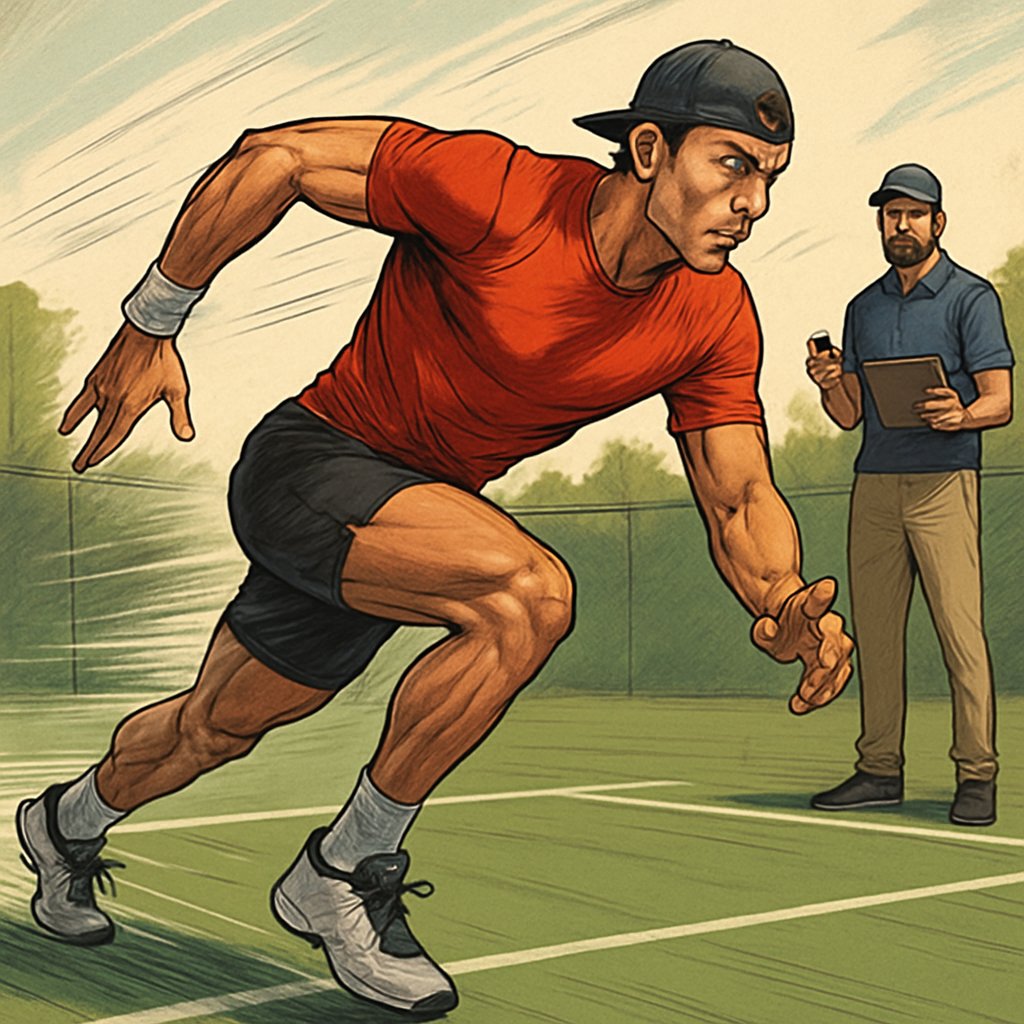
To really benefit, you need structured on-court sessions that blend movement drills with tennis-specific skills. Good timing and enough rest help you keep that burst of power all through your training blocks.
Structuring On-Court Drills
Start each session with explosive first step drills before picking up a racquet. That way, your muscles wake up and you avoid early fatigue.
Do 3-4 acceleration drills, each lasting 10-15 seconds. Focus on the split-step and changing direction fast. Rest 30-45 seconds between each one.
Progressive Drill Structure:
- Phase 1: Just movement (about 5 minutes).
- Phase 2: Movement plus stationary ball feeds (10 minutes).
- Phase 3: Movement with live ball drills (15 minutes).
Mix in lateral movement training while practicing groundstrokes. Set up cones 6 feet apart and work on explosive side-to-side steps as you hit forehands and backhands.
Combining tennis skills with movement patterns is what actually sticks. That’s how you build muscle memory for those split-second reactions in real matches.
Periodization and Recovery Strategies
Match your training intensity to your competition schedule. Plan explosive movement sessions 2-3 times a week during the off-season.
Weekly Training Schedule:
| Day | Focus | Intensity |
|---|---|---|
| Monday | Explosive drills | High |
| Wednesday | Movement + technique | Medium |
| Friday | Match play | Variable |
Cut back to once a week during tournaments. Your body needs time off to keep your legs fresh for matches.
Leave at least 48 hours between tough explosive sessions. This helps you avoid overtraining and keeps your fast-twitch muscles firing.
Focus on sleep and nutrition during heavy training weeks. Recovery is what lets your nervous system adjust to all those explosive moves.
Frequently Asked Questions
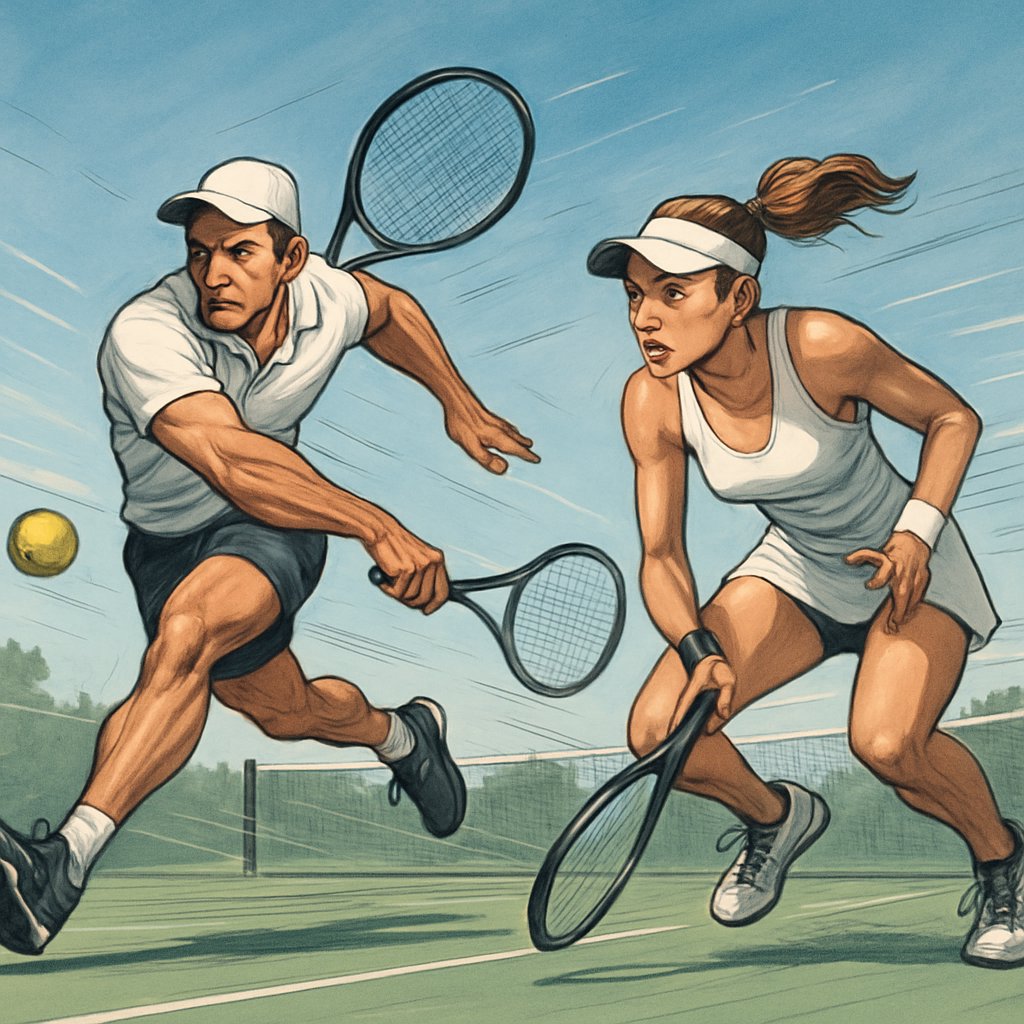
Tennis players always seem to want specifics on explosive movement training. It’s about picking the right drills, knowing how often to train, staying safe, and figuring out how these skills show up in real matches.
What are effective drills to improve first step quickness in tennis?
Cone drills are a classic way to build explosive first step speed. Try lateral shuffles between cones spaced 3-5 feet apart. That sharpens the quick direction changes you need in matches.
On-court cone drills help you move explosively while staying low and balanced. Keep your form solid through every rep.
Shadow swings with fast footwork are great for tennis-specific speed. You practice your swing and layer in quick steps. It’s a solid combo for technique and speed.
How does plyometric training enhance explosive power for tennis players?
Plyometric exercises train your muscles to contract fast and hard. They boost the stretch-shortening cycle in your muscle fibers, so your body gets better at storing and releasing energy.
Plyometric drills and exercises are a staple in modern tennis. Coaches see their value for agility and quickness.
Jump training gives you the pop you need for quick direction changes. Your legs get stronger at pushing off in any direction.
Can improved first step quickness significantly impact a tennis player’s performance?
When your first step gets quicker, you reach more balls. Sometimes you chase down shots that would have been winners before. That can really flip the script in a match.
Sharp reactions help you get into position for your shots. You end up with more time to set up, and that usually means better shots and smarter court coverage.
Tennis-specific agility training boosts your reaction time and quickness on court. The benefits are pretty clear for players who put in the work.
What plyometric exercises are recommended for tennis players seeking quicker court movement?
Box jumps are awesome for vertical power. Start with a 12-16 inch box and focus on landing softly. Your legs will learn to spring up and down with more force.
Kettlebell lateral lunges are great for tennis because they hit lateral movement and core strength. They really help with those quick side steps on court.
Broad jumps build horizontal power for moving forward and back. Jump as far as you can and stick the landing. That movement carries over to covering court space.
Broad jumps are great for increasing horizontal power, enhancing your explosive movement training tennis.
How often should tennis players incorporate explosive movement training into their routine?
Work on explosive movements 2-3 times a week during the off-season. That gives your muscles time to recover and get stronger.
In competition season, drop to 1-2 times a week. Focus on keeping the power you’ve built, and don’t overdo it when you’re playing a lot of matches.
Focused fitness and footwork training should stay in your routine year-round. Regular sessions help you keep your edge.
What measures can a tennis player take to safely increase explosive speed without injury?
Start with a solid warm-up before any explosive training. Spend about 10-15 minutes doing dynamic stretches and light movement.
Focusing on safe practices during explosive movement training tennis is essential for long-term success.
Your muscles deserve a chance to get ready for high-intensity work. Trust me, skipping this part just isn’t worth the risk.
Increase your training intensity and volume slowly. Don’t bump things up by more than 10% a week—seriously, patience pays off here.
Trying to rush usually backfires, leading to injuries or annoying setbacks that could’ve been avoided.
Resistance band training is a smart option. Bands give you constant tension but are easier on your joints.
They target tennis-specific movements and help you build strength without pounding your body. Honestly, it just feels safer and more controlled.
Keep your focus on good form, not just speed. Nailing the technique protects you from injury and actually builds better habits in the long run.
In conclusion, regular explosive movement training tennis can transform your court performance.
Quality matters way more than cranking out tons of sloppy reps, especially when you’re working on explosive power.
